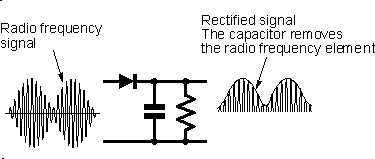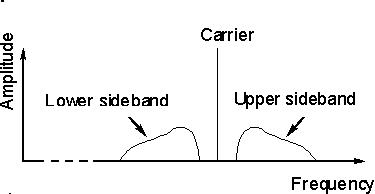Radio receiver amplitude modulation (AM) demodulation
- overview or tutorial of the basics of amplitude modulation ( AM )
demodulation or detection using a diode detector or demodulator.
One of the advantages of amplitude modulation (AM) is that it
is cheap and easy to build a demodulator circuit for a radio receiver. The
simplicity AM radio receivers AM is one of the reasons why AM has remained in
service for broadcasting for so long. One of the key factors of this is the
simplicity of the receiver AM demodulator.
A number of methods can be used to demodulate AM, but the
simplest is a diode detector. It operates by detecting the envelope of the
incoming signal. It achieves this by simply rectifying the signal. Current is
allowed to flow through the diode in only one direction, giving either the
positive or negative half of the envelope at the output. If the detector is to
be used only for detection it does not matter which half of the envelope is
used, either will work equally well. Only when the detector is also used to
supply the automatic gain control (AGC) circuitry will the polarity of the diode
matter.
The AM detector or demodulator includes a capacitor at the
output. Its purpose is to remove any radio frequency components of the signal at
the output. The value is chosen so that it does not affect the audio base-band
signal. There is also a leakage path to enable the capacitor to discharge, but
this may be provided by the circuit into which the demodulator is connected.

A simple diode detector (demodulator) for AM signals
This type of detector or demodulator is called a linear
envelope detector because the output is proportional to the input envelope.
Unfortunately the diodes used can introduce appreciable levels of harmonic
distortion unless modulation levels are kept low. As a result these detectors
can never provide a signal suitable for high quality applications.
Additionally these detectors ( demodulators ) are susceptible
to the effects of selective fading experienced on short wave broadcast
transmissions. Here the ionospheric propagation may be such that certain small
bands of the signal are removed. Under normal circumstances signals received via
the ionosphere reach the receiver via a number of different paths. The overall
signal is a combination of the signals received via each path and as a result
they will combine with each other, sometimes constructively to increase the
overall signal level and sometimes destructively to reduce it. It is found that
when the path lengths are considerably different this combination process can
mean that small portions of the signal are reduced in strength. An AM signal
consists of a carrier with two sidebands.

Spectrum of an amplitude modulated (AM) signal
If the section of the signal that is removed falls in one of
the sidebands, it will change the tone of the received signal. However if
carrier is removed or even reduced in strength, the signal will appear to be
over modulated, and severe distortion will result. This is a comparatively
common occurrence on the short waves, and means that diode detectors are not
suitable for high quality reception. Synchronous demodulation ( detection ) is
far superior.
|